Sharing Experience
One of the initial purposes of this project is to encourage the community to form groups for similar book translation projects. Therefore, we would like to share our experience as honestly as possible, including both our successes and shortcomings, along with actual data and documents to help others prepare better.
1. Principles & Objectives of DLBookVN
1.1. Principles
- Non-profit. We do not charge translation fees for the book, striving to keep the book price as low as possible while still ensuring quality and covering storage, marketing, and distribution costs. Any surplus (if any) will be entirely donated to the Books for Rural Areas Vietnam program by Mr. Nguyen Quang Thach.
- Quality. We chose the Deep Learning book for its comprehensiveness. It is considered the introductory textbook for students and engineers who want to learn and apply deep learning. We focus on translation quality, carefully crafting terminology, adding notes, and providing additional explanations for readers’ convenience.
- Respect for Copyright. We agreed from the beginning to absolutely respect copyright. We also planned to purchase publishing rights as soon as the group was formed. In reality, copyright issues are not always properly valued in Vietnam in many cases. Through our copyright work, we hope to contribute to raising awareness about copyright issues in the community.
1.2. Objectives
- Create reliable, standardized Vietnamese reference materials for the AI/ML/DL field in Vietnam.
- Contribute to standardizing terminology for the AI/ML/DL field used in teaching, scientific documents, and administrative texts in Vietnamese. Accordingly, we have published the complete terminology appendix, see section (1.3).
- Inspire and encourage knowledge-enhancing activities for the Vietnamese technology community. Therefore, we always strive to keep the book price within a range that most students and working professionals can afford and are willing to pay.
2. Organization Structure
The responsibility of organizing the group is mainly handled by 3 co-founders, listed in alphabetical order:
- Nguyen Anh Duong: the first person to call for the group’s formation, participated in translation and revision of the entire book.
- Le Viet Hung: advisor on translation, mathematical knowledge, and in-depth AI/ML/DL expertise, participated in revision of the entire book.
- Tran Duy Thanh: created the Slack channel, managed group email accounts, website, work distribution, progress monitoring, translation terminology advisor, especially Sino-Vietnamese elements in terminology, revised the entire book.
During the translation process, the group had up to 100 members at one point. Mr. Le Viet Hung proposed the following organizational model:
- Divide work by chapter. Specifically, the number of translators per chapter is proportional to the chapter length. On average, each member translates 5 pages—the book is 500 pages and we had 100 people. The number of pages per member is not much, and the most time-consuming issue is not translation but ensuring consistency in translation, making the book translated by 100 people read as if translated by one person.
- Chapter editing. Each chapter has one or two designated chapter editors. The role of chapter editors is to ensure consistency within each chapter, especially in terminology usage and writing style. Chapter editors coordinate members participating in that chapter’s translation.
- Overall editing. We have 6 members taking on the role of cross-chapter editors. The overall editing team ensures consistency between chapters, from terminology to writing style. Each member of the editing team must read the translation multiple times to ensure consistency.
As mentioned above, the overall editing phase is the most time-consuming. In the first few months after the group’s formation, we completed the first draft translation of the book. However, the overall editing phase lasted 2-3 years. (After the first draft was completed, more than 90 people in the project no longer continued.) During those years, there were times when the entire editing team was “exhausted,” seemingly unable to complete the project due to various issues. Partly because the book was too long, and the related knowledge in the final chapters was at a very high level, encompassing many different fields, making editing and revision very difficult. Later, thanks to the persistence of the overall editing team, including the 3 co-founders and members, listed in alphabetical order:
- Ngo Quoc Hung (CoTAI)
- Vo Tan Phat
- Le Thi Thuy Trang
- Nguyen Xuan Tu
as well as the addition of a new member
- Lai Ngoc Chi
that the project was completed. Chi created a smart financial plan and specific marketing strategy. Chi helped the whole team “see” the end point of the project, creating additional motivation for the team to focus on the “final sprint” phase and complete the project.
Comment: The initial phase of the project developed very quickly, with a large number of translators. But the success/failure of the project mainly depends on a few members who pursue the project to the end. This also means that these members have sacrificed a large amount of time and effort for the project. We believe this is a valuable experience in non-profit projects: the founding team should find some dedicated members to pursue the project to the end, and the founding team itself should be prepared to devote most of their time to the project.
3. About Translation
3.1 The Problem
Those working in technical fields during the recent years of continuous technological advancement have encountered many difficulties with terminology issues such as:
- Not knowing what the corresponding Vietnamese term is? Has it been translated before?
- Individual level not sufficient to translate into Vietnamese, and having to temporarily use English terms or rough translations. Some extreme cases often blame Vietnamese for being imprecise?!?
- Multiple translations existing simultaneously for the same English term.
- And so on.
From these inconveniences, there exists a tendency in the technical community to avoid translation, even preventing the translation of terms, books, blogs, etc. into Vietnamese. The main reasons include:
- Creating pressure for the next generation to learn English.
- Vietnamese cannot express as precisely as English.
3.2 Our Viewpoint
We believe both reasons above reflect the laziness and lack of understanding of translators in studying both Vietnamese and English. It can be said that keeping English terms is the easiest thing anyone can do. To translate a term into Vietnamese, sometimes we have to research and debate for many days. Why do we spend so much time on terminology translation? From our perspective - people who want to bring knowledge to a wide audience and have years of experience in teaching/sharing knowledge - we believe that:
- Term translation is necessary to have standard words for scientific research documents in Vietnamese.
- Vietnamese terms - once carefully translated and annotated - are particularly beneficial for the teaching and knowledge dissemination process. Additionally, people outside the technical field can access it more easily. People tend not to love what they don’t know (ignorance breeds indifference). Disseminating human knowledge in the mother tongue helps save readers’ time. It helps inspire passion from readers. We want to be clear: we do not exclude English terms. On the contrary, we encourage readers to learn the original English terms through annotating the original English terms alongside the translation. This can also create inspiration for readers to have more motivation to learn English and integrate with the world. We want to encourage the younger generation through knowledge and passion arising from understanding, not by not translating to force people to learn foreign languages.
- Overusing English terms creates unnecessary difficulties for beginners. Additionally, it obscures the meaning of terms, as most users only see them as proper names without paying attention to the meaning of the term.
- Term translation requires relatively deep understanding of:
- (1) English etymology.
- (2) Vietnamese etymology.
- (3) Professional knowledge.
- (4) Some cases require even the history and context of the term’s creation.
- Must know English terms for easy reference and in-depth study, keeping up with the world. Using bilingual terms brings many thinking advantages for learners.
- Should develop Vietnamese language capabilities for the technical community. The characteristic of popular/artistic writing style is “suggestive,” a bit of ambiguity increases suggestiveness, and skillful use of language ambiguity is an art. The characteristic of scientific writing style is “specification,” where unambiguity and clarity are emphasized to avoid the “Chinese whispers” phenomenon. Vietnamese, English (and other developed languages) all have both writing styles. The development of science in Vietnam will promote the development of scientific writing style in Vietnamese. We are fortunate to inherit the thousand-year heritage of Vietnamese from our ancestors, this is an extremely rich and precise language, and we need to know how to utilize it. Most English learners first encounter scientific writing style, especially those studying abroad and working in technical fields, with little exposure to popular writing style (because they don’t live long enough in English-speaking communities) so they often feel that English is unambiguous and standard. On the other hand, frequent exposure to popular writing style in native Vietnamese communities, and limited time exposed to scientific writing style in Vietnamese, easily creates the feeling that Vietnamese is ambiguous and imprecise. Because Vietnamese is our mother tongue, we easily mistake that we understand Vietnamese well.
Some terms in our book we keep in original English, partly because we failed to find equivalent Vietnamese terms. The decision to keep English in the translation must be agreed upon by all editors, from chapter editors to overall editors.
Although not perfect, we are finally quite satisfied with our terminology set, and we hope the community will popularize and/or continue our journey of finding standard Vietnamese terms.
3.3 Translation Criteria
We believe a good term needs the following criteria:
- Well expresses or well reminds of technical content.
- The less ambiguous with other terms, the better.
- Concise and succinct.
- Friendly, easy to understand (not using too strange or archaic words)
- Close to English terms (to easily guess the corresponding English term when needed).
During teaching/sharing, we boldly use both terminology sets simultaneously. Among them, English terms are for easy reference, and Vietnamese terms are for easy teaching. (And of course we also love our mother tongue.) We have attached more than 600 terms at the end of the book. This is the achievement that the group wants to contribute to the community. We have put all these terms on this website, please see here: Terminology Appendix.
4. Tools Supporting the Translation Process
Facebook.
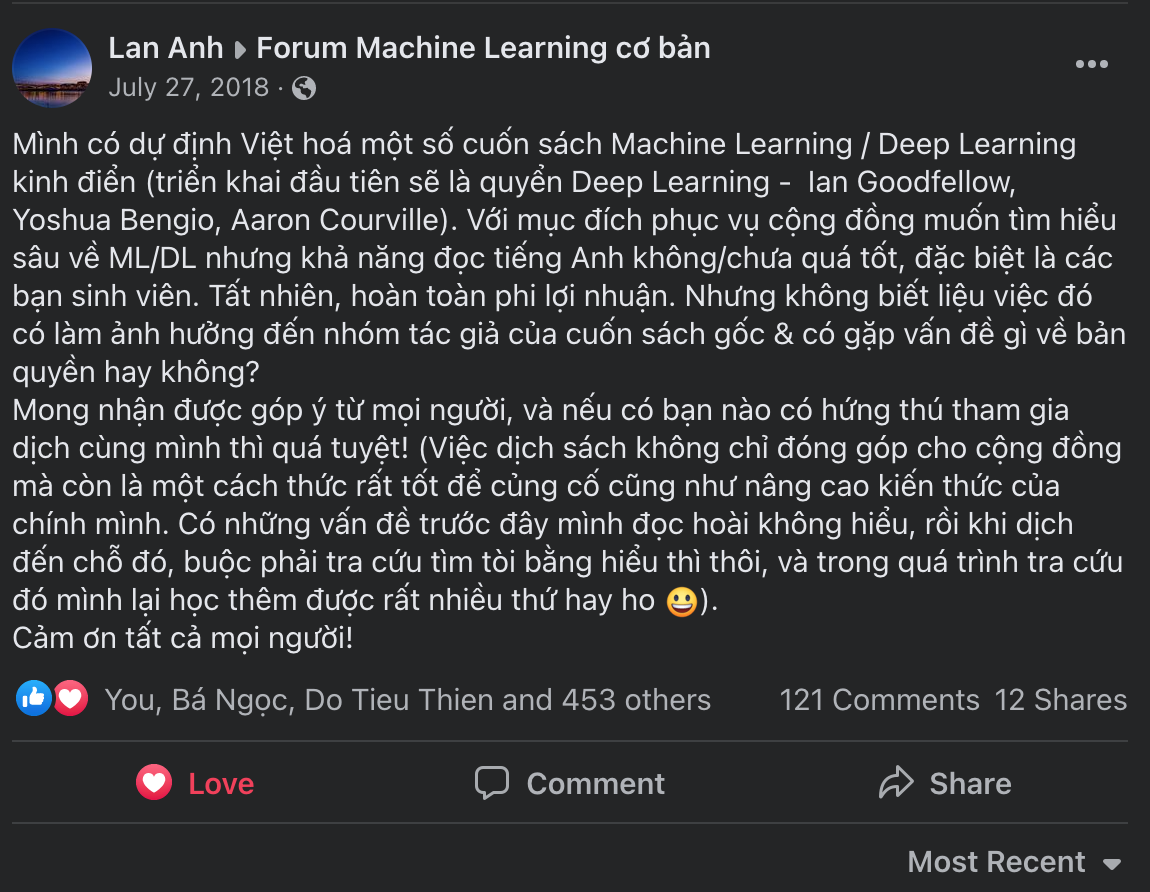
This is where we gathered and initiated the project. Facebook is also the channel for us to update the project’s progress to the community, as well as announce the Deep Learning Book Project.
Slack.
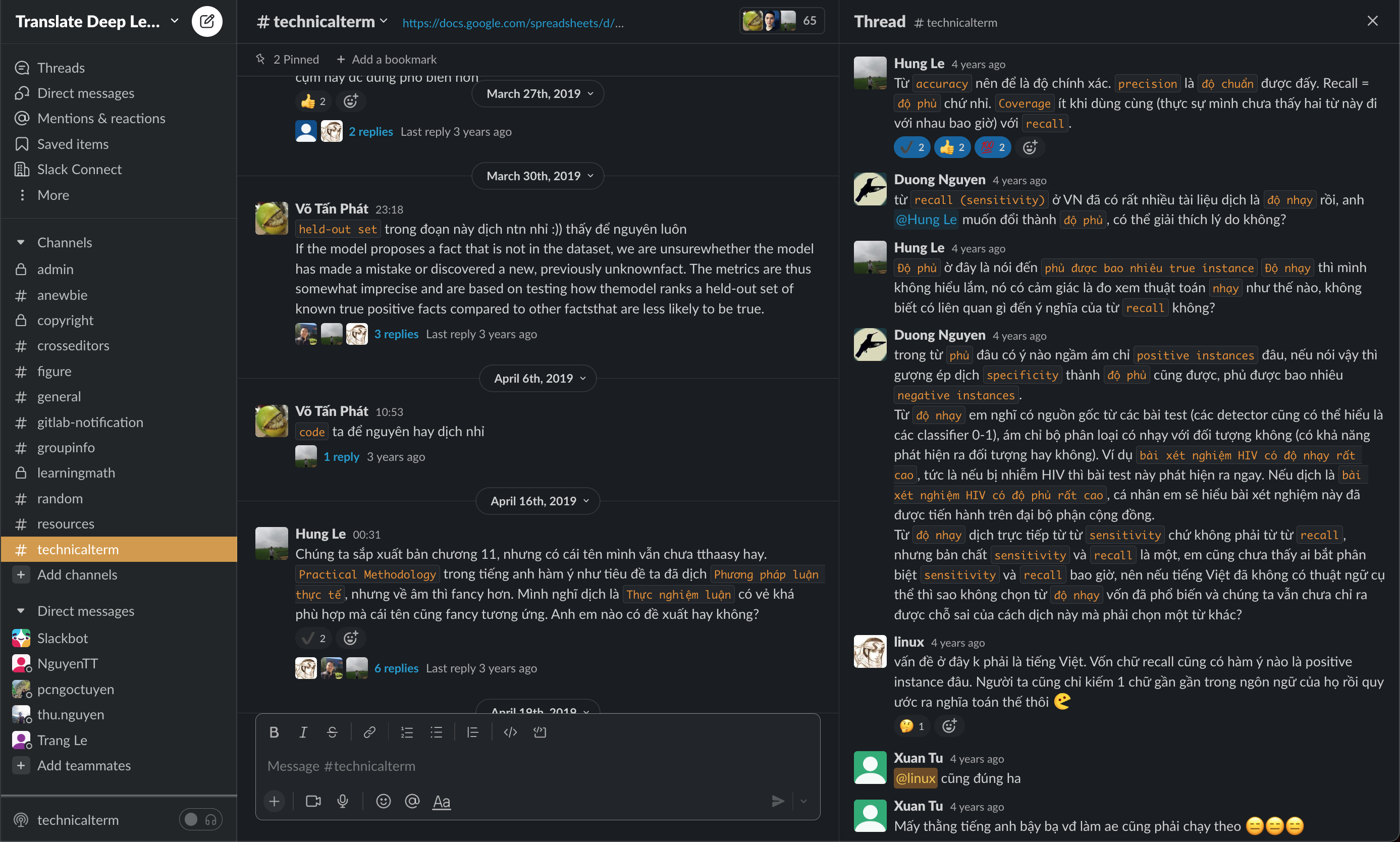
Slack’s multi-channel, multi-thread, notification mechanism helps effectively separate discussion topics and coordinate activities. We created a dedicated channel for in-depth translation discussions here.
GoogleSheet. We use Google Sheet to list translated or untranslated terms, possible translation options, and quick notes. Reasons:
- Easy to use. We know that technical community members often use github/gitlab, issue creation, merge-request mechanisms like in the case of the Dive into Deep Learning translation group (d2l-Discussions, d2l-Terminology Table). But because our group has diverse members with different levels and fields, GoogleSheet is the most suitable option.
- Easy to search, sort, and statistics.
- Online tool with automatic backup.
Voting. We compare with the translation criteria as above, in cases where multiple translations satisfy these criteria, we choose voting to decide the official option.
hackmd.io.

See more here. In the early stages of the project, also because our group has diverse members, levels, and fields, Latex was not a suitable tool at this time. We chose Hackmd tool for the following advantages:
- Very easy to learn and use. New members only need 15-30 minutes to start using it with the group.
- Text editing in Markdown for consistent formatting. Split screen allows previewing the result text during raw editing.
- Supports mathematical formula typing similar to Latex.
- Multiple people can participate in simultaneous editing.
- Allows web interface export.
- Automatically backs up content and change history, making it easy to trace back or revert to old versions when errors occur. This function is quite similar to github/gitlab.
Gitlab.

At the time of 2018, we found Gitlab had more suitable supporting utilities than Github. However, only the management board uses Gitlab for the purpose of backing up translation results corresponding to each stable version. Other members all translate on hackmd.io. Additionally, we use the free, available tool Gitlab Page to make the official website for the group, as well as publish preview chapters, honor and acknowledge member contributions.
Latex.
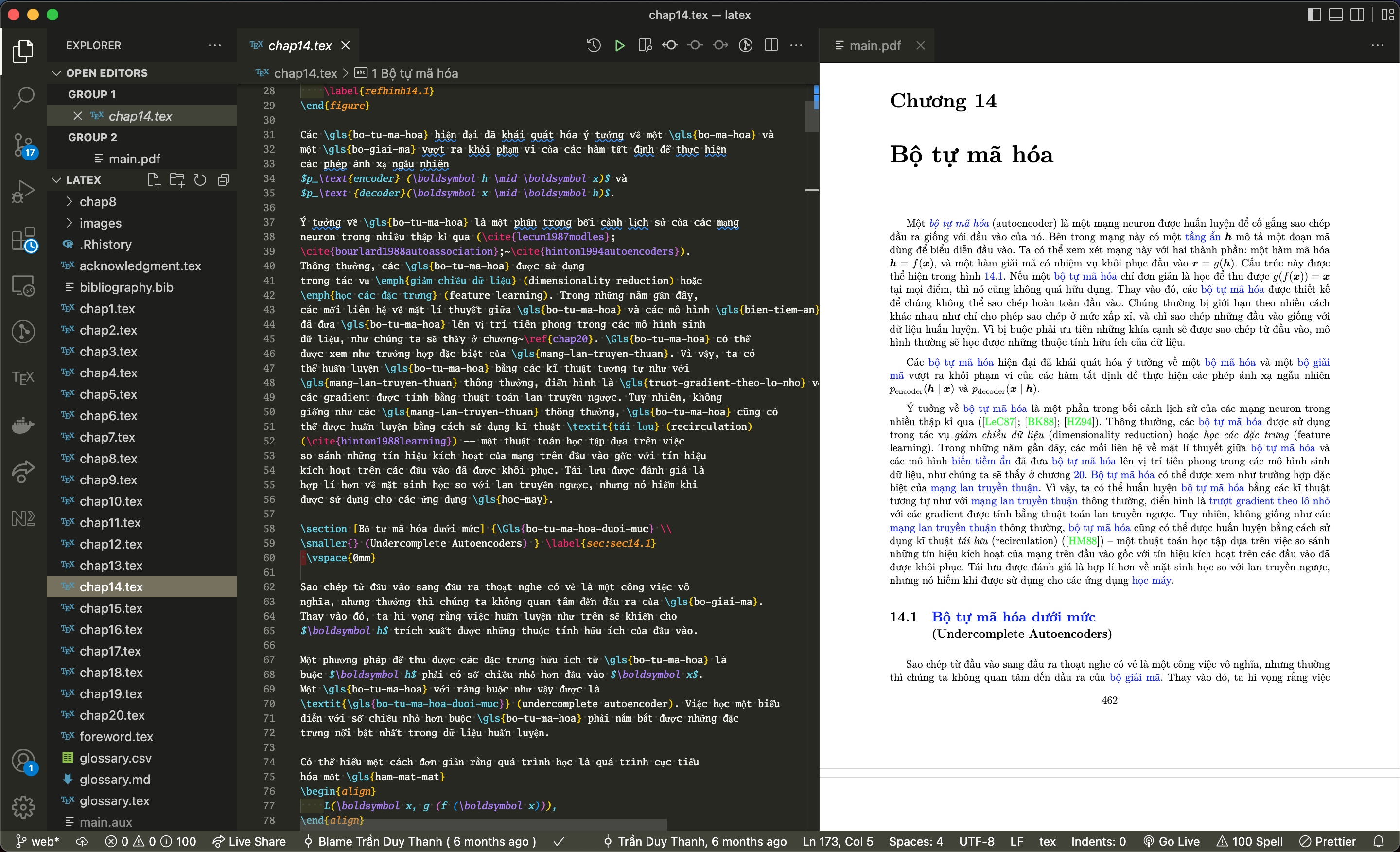
In the comprehensive content revision rounds from 2021, we officially stopped using GoogleSheet and hackmd, completely switching to using Latex and Gitlab as main tools because:
- The number of members participating in revision was reduced to just a few, mainly the management board, all with extensive experience using Latex, Gitlab/Github.
- Standardize content, format, and book presentation standards, preparing for publication.
- Terminology management. We use the glossaries library in latex to manage these terms throughout the text. This library helps us a lot in the book revision process. With more than 600 terms, 20 chapters with more than 700 pages of content, without this tool it would be a real headache. GoogleSheet is only effective in the early stages, when there’s still a lot of discussion needed.
Adobe Illustrator & Photoshop. There are more than 70 illustrations and graphs in the book that need to be redrawn (vectorized) to ensure quality when printing, in addition to translating the content in the images.
5. Obstacles and Arising Issues
We would like to highlight some notable cases to share with those intending to form book translation groups, helping you prepare mentally and plan appropriate solutions.
5.1. Lack of Copyright Respect.
Basically, we want to comply with copyright law because:
- Contribute to creating a good impression with the world about Vietnam’s academic and translation environment.
- Want to encourage future translation groups to comply with this.
- Avoid potential legal copyright issues for members participating in translation.
However, there have been cases where group members deliberately leaked the translation (unrevised) to the outside. So how to handle this? We accept that this issue is unavoidable, and we also don’t have many resources and time to solve it thoroughly. We chose to announce in the group and on Facebook to let the community know about the group’s position, and then focus only on perfecting the quality for the official version.
5.2. Finance
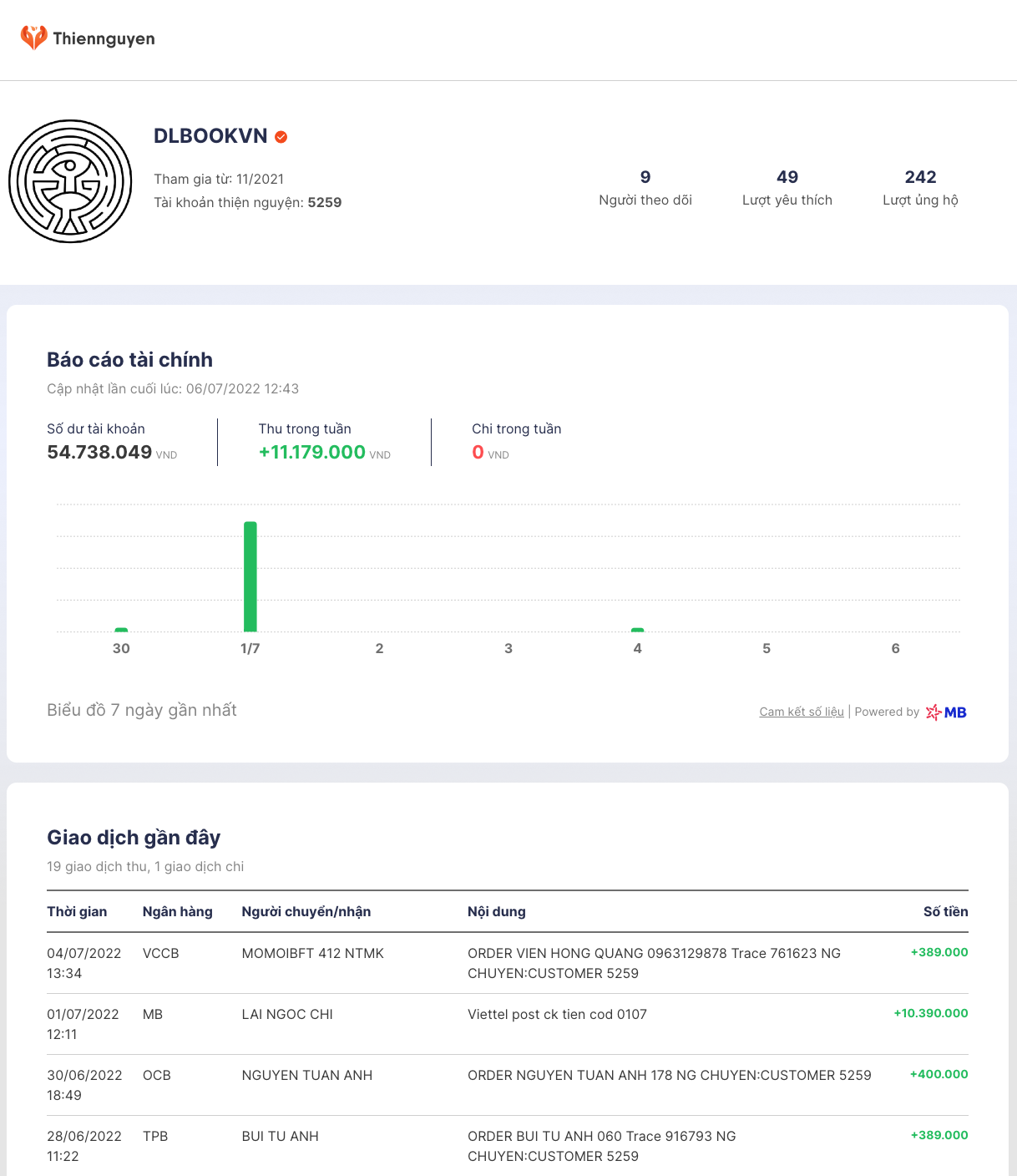
Most non-profit or charitable groups easily encounter financial troubles. We didn’t encounter any problems during the book translation process, but when we needed to implement book publishing steps, this was a big issue. We use a charity account at Military Commercial Joint Stock Bank (MBBank). This is a type of account where anyone (not the account holder) has the right to request a statement of all money transfers in and out. This helps relieve the responsibility burden from the individual who created the account. The group hardly needs accounting operations or similar. Financial activities are naturally ensured to be transparent and public through the built-in features of this account type. You can view our transaction history here Statement. MBBank usually takes 1-2 weeks to review and approve this charity account type (as of November 2021). If you intend to create a similar account, you should consider doing it early.
5.3 Mutual Suspicion.
Some members may have suspicions about other members or the management board. Common suspicion issues are:
- Management board hiding information.
- Management board having personal interests in the translated content.
- Member X having personal interests, having private motives.
The solution we chose to solve the problem:
- Proactively communicate with members who have concerns. In cases where concerns cannot be resolved, we choose to stop collaboration.
- Continuously publicize information (weekly), transparent about management board member activities, as well as overall project progress.
- Review and stop collaboration with members who are less active or ineffective.
6. Unifying Writing Style, Revision
We completed rough translation in less than 1 year for 20 chapters with more than 700 pages. However, the most time-consuming phase, determining the book’s quality, is revision. Notable issues such as:
- Inconsistent writing style. Based on trust, we selected a core group with 6 members (in alphabetical order: Nguyen Anh Duong, Le Viet Hung, Vo Tan Phat, Le Thi Thuy Trang, Tran Duy Thanh, Nguyen Xuan Tu) to revise the writing style for the entire book in 4 rounds.
- Misunderstanding the author’s intent. This is hard to avoid when the group has many people participating with different levels. Honestly, partly because there are many passages where the author writes unclearly, or writes awkwardly, or requires deep background knowledge to grasp. Assigning a core group to revise the entire book is the only solution we implemented to review these questionable passages.
- Spelling errors. We use Google Docs to help detect about 70% of obvious spelling errors, the remaining 30% of errors can only be detected manually by reading and checking each word.
- Inconsistent terminology. While most terminology was consistent within the group, having multiple individuals simultaneously translating different parts made it difficult to avoid inconsistencies in some places. Once again, manual review of each word, comparing between the Vietnamese translation and English original, was the only method we used to fix these errors.
- Spelling rules for y-i and accent placement (e.g., òa-oà). The spelling rules for Vietnamese script have clear regulations for these cases. However, due to existing habits and different viewpoints, the y-i rules and accent placement rules are often not strictly followed. On our part, while we respect personal preferences and viewpoints, we also encourage adherence to these spelling rules in specialized texts such as scientific and administrative documents.
7. Number of Members, Efficiency
Having many members does not necessarily mean efficient operation. Managing 100 members consumed a significant amount of the management board’s time. It would be much more efficient if this time was used by the management board for translation and revision.
After completing the publication of this book, we looked back and believe that: the ideal number of members for this project is around 10 people. The minimum number of members needed to run the project smoothly is 5 people. What are the advantages of a small group?
- The group is more cohesive, works more harmoniously, and members’ skill levels are more similar.
- Information spreads and updates quickly within the group, thereby minimizing discrepancies or inconsistencies in the translation process.
- Time spent on group management is negligible, allowing more time to focus on the book.
So are large groups not good? No, actually a group of 100 people also has its advantages:
- The project’s outreach is stronger, and it also helps connect with many high-quality members.
- Ability to select specialized members, such as members specialized in editing images in the book.
- Many enthusiastic members help with manual tasks such as:
- Proofreading for spelling errors.
- Checking formulas.
- Checking for inconsistent terminology.
- Some members who participate less in translation are enthusiastic about using the knowledge gained during the translation process for their other training projects, helping us better understand the practical significance of our project.
What kind of members does a book translation group need?
- Experts. In our group’s case, that would be Mr. Le Viet Hung and Ngo Quoc Hung. Additionally, in the early stages, our group had many members who were PhDs, researchers, and Masters.
- Management. During the peak period with 20-60 members simultaneously, Mr. Tran Duy Thanh took on this role. Later, when there were only 3-15 people, this role was almost no longer necessary.
- Marketing and contract-related work, negotiations. Initially, the group had no dedicated person, Mr. Tran Duy Thanh took on this role but was not effective. Later, Ms. Lai Ngoc Chi (with extensive experience in book publishing) joined the group and showed significant improvements. Without her, it might have taken nearly another year for the book to reach readers. In cases without such a member, we think you should seek support from active individuals working in the publishing industry for detailed guidance. Our group is willing to share experience, or you can also contact Mr. Vu Huu Tiep’s group.
- Regular translation team.
- Moderate enthusiasm. “Moderate” means being able to follow a project until completion or for a long enough time to complete a few chapters, but not being so enthusiastic as to create pressure for oneself and others, nor being so inconsistent as to leave assigned tasks unfinished.
- Capability. From our observation, members with about 5 years of programming or mathematics, data science experience, working in environments that frequently use English and English documents, having at least 3 years of teaching or sharing experience, having self-translated articles or books, and being able to express fluently usually have the most stable translation efficiency and quality.
- Open attitude. Knowledge is vast and has many intricacies, and there will be many translation points that lead to debates with different opinions. Fortunately, our members were quite serious, open, and not lacking in humor during academic discussions. Book translation is challenging work, and we still had joy and hearty laughter while working together.
Above is the practical experience of operating a non-profit project with high academic requirements, completely online, with a large workforce in the first year and a small workforce in the last 2 years, with personnel scattered across Vietnam and the world. We hope this will help you in the process of creating your own translation group.
8. Copyright
8.1 Types of Copyright
When we started this project, we had very limited knowledge about copyright types. As we began planning for publication, we learned about three main types of copyright:
- Author’s copyright: This determines who owns the original work (in this case, the English version of the book).
- Publishing rights: In our case, MIT Press holds these rights (regardless of the language of publication). Anyone wishing to publish the Deep Learning book in any language (English, Vietnamese, Chinese, Japanese, etc.) must obtain permission from MIT Press.
- Translation rights: Since our group created the Vietnamese translation, we have the right to register copyright for this translation. While not mandatory for publishing, we were advised to register the translation copyright early to prevent potential legal issues in the future.
For printing 1,000 physical copies, we only needed to secure publishing rights from MIT Press. This meant we did not need to contact the three original authors of the book.
8.2 Finding a Publishing Partner
Our initial plan was to release a free online version for the community. However, after over a year of seeking support (since completing the first revision), we were unable to secure the necessary rights to make this possible. The most viable alternative was to publish a physical book. This proved to be a more straightforward option as there are many established domestic publishers with extensive experience in this field. After reaching out to several publishers, we ultimately partnered with The Gioi Publishing House.
8.3 Publishing Rights Authorization
Based on publishing industry experience, we were advised to collaborate with a domestic publisher who would handle the negotiations and contract signing with MIT Press.
We hired The Gioi Publishing House to act as our representative in signing the contract with MIT Press for permission to publish 1,000 physical copies of the Vietnamese version.
The service contract for purchasing publishing rights with The Gioi Publishing House:

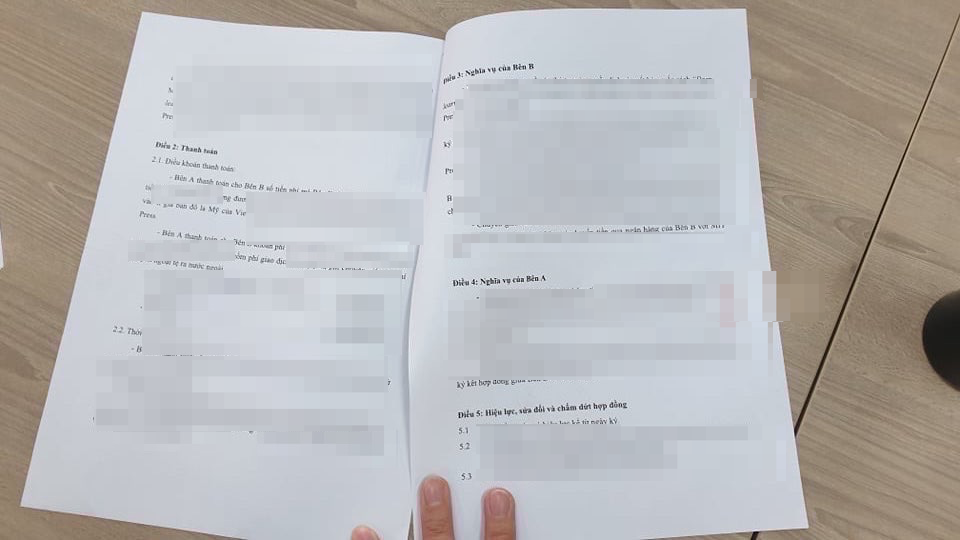
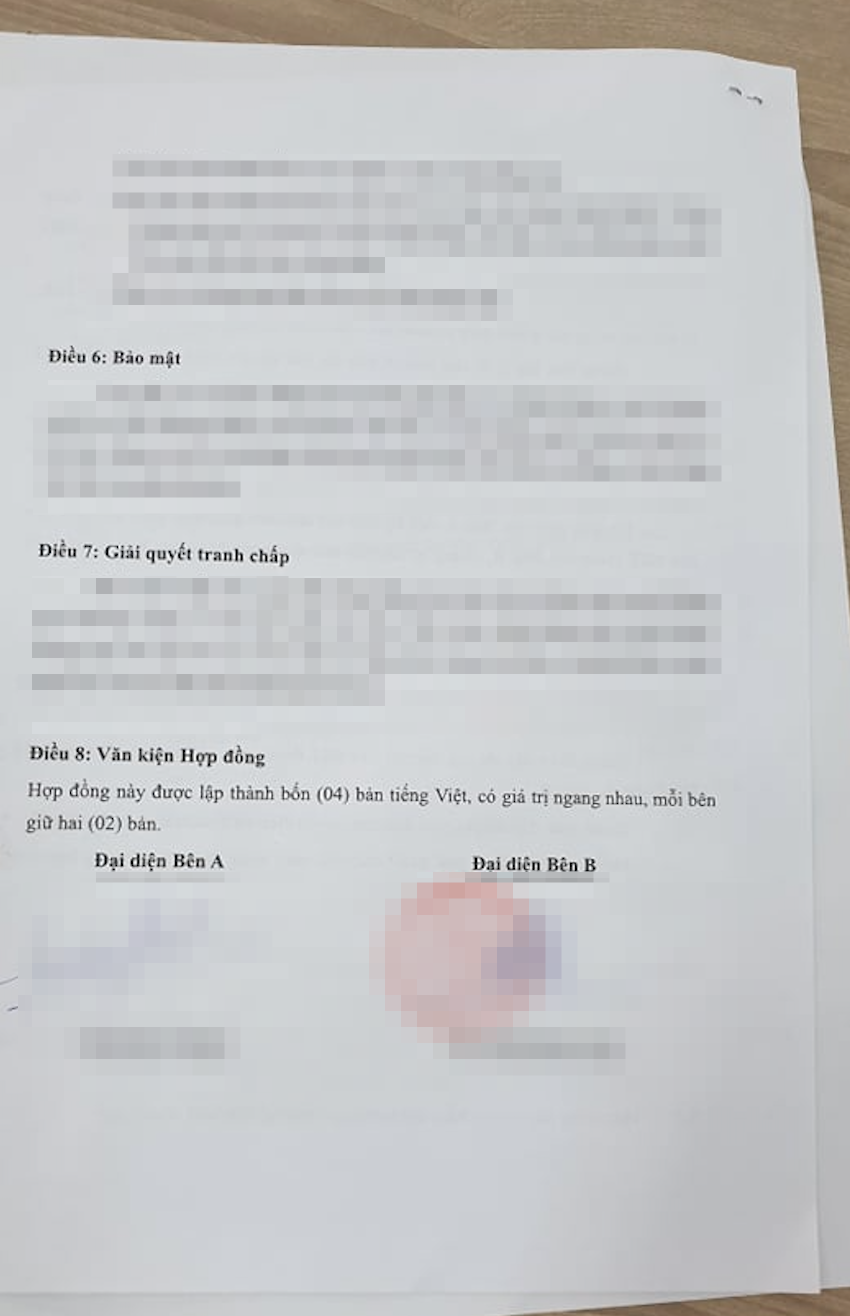
The contract with MIT Press:
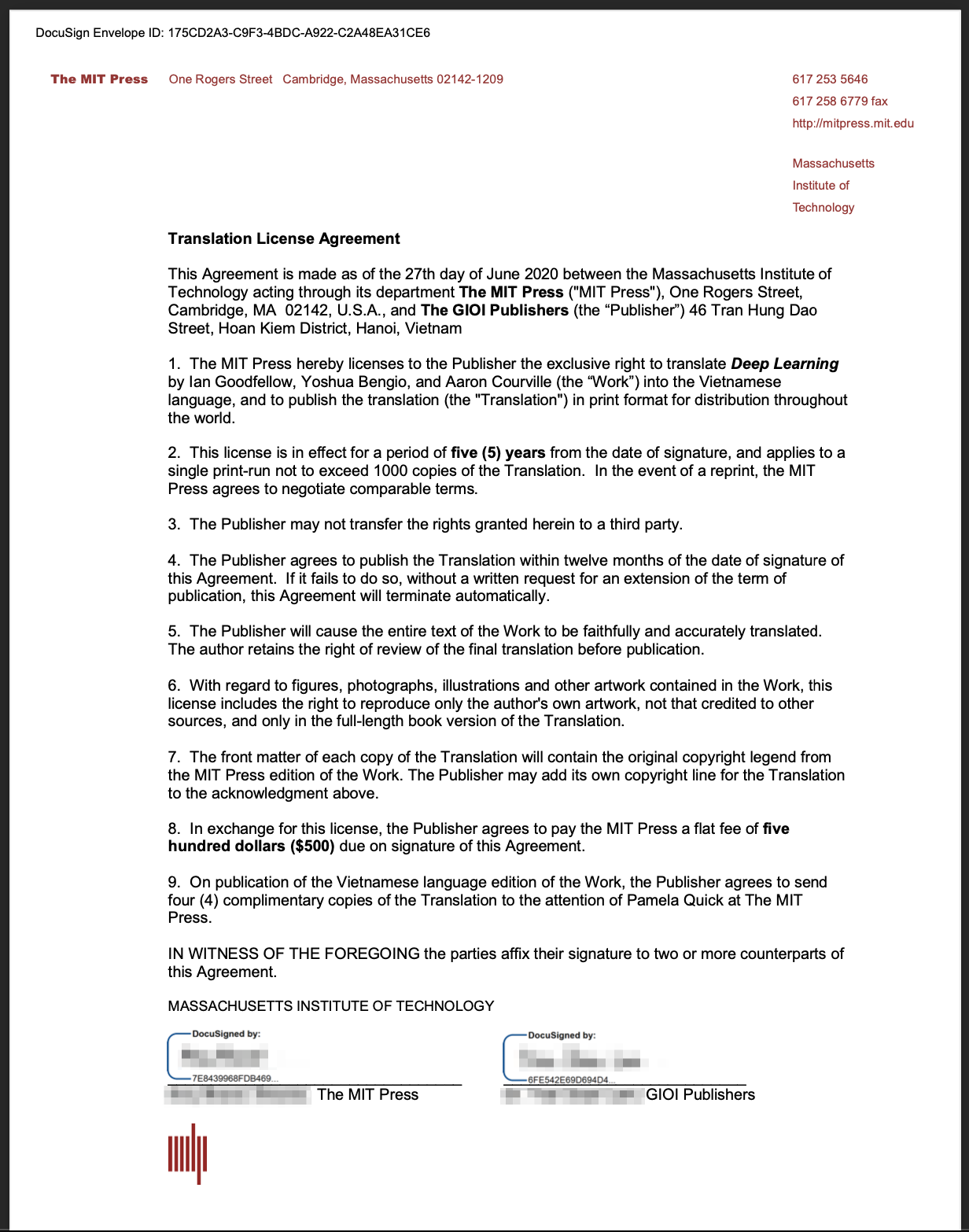
9. The Complete Product
When publishing a physical book, besides completing the book’s content, we needed to pay attention to many small details, taking about 3-4 months to complete. These include:
9.1 Cover Design
You can design it yourself, hire a separate designer, or commission the publisher you’re working with to design it. Regardless of which option you choose, you need to continuously consult with the publisher because cover design involves many factors such as:
- Cover type (hardcover, softcover, pocket softcover, dust jacket, fold-over cover…)
- Cover printing techniques (and their associated costs)
- Spine thickness and design (closely related to page count and paper type)
- Sponsor logos and images (if any)
- Excerpts, author information, translator information on the fold-over or back cover…
9.2 Printing with LaTeX Files
If you deliver files in doc or docx format, the publisher can handle the typesetting and layout. For technical books, we typically use LaTeX, and we found that no tool can convert from LaTeX to doc/docx while maintaining quality. For this reason, we worked closely with the publisher to understand the layout specifications (margins, font size, font type, layout, image placement…) and adjusted everything ourselves according to these specifications. Finally, we delivered a PDF file. The publisher will print based on this PDF file.
9.3 Paper Material and Book Size
Our book has over 700 pages and more than 70 color images, some requiring many colors, so we needed to choose appropriate paper to prevent smudging, color shifting, or issues with ink showing through thin pages or making the book too thick with thick paper.
If the book size is too small, we would need to reformat the layout, increasing the page count. If too large, shipping would require larger boxes, and customers would find it harder to carry around. We chose a size approximately equal to A4 paper.
9.4 Additional Book Information
Including:
- Book reviews. We sent part or all of the content to leading Vietnamese experts in AI/ML/DL for feedback, comments, and book reviews.
- Sponsor information. As this was one of the benefits we offered to thank our sponsors, we worked with them to gather necessary information. For corporate sponsors, this process took longer. We spent about a month completing the sponsor information collection, reviewing content for the book, and getting sponsor feedback for appropriate adjustments.
- Translation team member information. Some members wanted their full legal names, some preferred nicknames or chosen names, and some requested anonymity… We respected each member’s wishes. Therefore, from the early days of translation, we asked for preferences and honored (or anonymized) members according to their wishes. Four months before official printing, we also announced widely again for members to make adjustments if needed.
- Preface.
- ISBN - International Standard Book Number. Each published version and change (except reprints) of a book will have its own ISBN. However, you don’t need to worry too much, as publishers typically help complete the necessary procedures to obtain ISBN numbers. The Gioi Publishing House enthusiastically supported us in this matter.
9.5 Sample Chapter
We chose Chapter 1, the most readable chapter, as our official sample chapter and published it on our group’s website.
Additionally, depending on the case, we also sent 3-4 sample chapters or the entire manuscript to teachers and experts to help evaluate translation quality, request feedback and suggestions for appropriate revisions, and obtain reviews for marketing purposes when selling the book.
10. Fundraising for Book Printing
10.1 Preparation
Including:
- Account. We created a charity account at MBBank as mentioned in section (2.2.2)
- Quotation. We requested quotes from the publisher to know the minimum print quantity (that the publisher would accept). The total cost corresponds to the number of books printed. This cost also depends on many factors as mentioned in section (4).
- After receiving the quote, we planned marketing, estimated storage costs, packaging, delivery, promotions, reserve fund, etc. The goal was to calculate the required amount for each stage:
- Printing stage
- Distribution stage for pre-ordered books
- Sales stage for remaining books with promotional campaigns until project completion
- Based on these numbers, we divided potential sponsors into groups and conducted fundraising in two phases with corresponding policies and timing. Simultaneously, we launched a pre-order campaign with significant discounts.
10.2 Preparing and Implementing Fundraising
We targeted two groups of sponsors:
- Companies and universities in the AI/ML/DL field. Most were companies we knew, had worked with, or had collaborated with in various academic activities. These were individuals and organizations who knew our group well, trusted our operating principles, understood our efforts, and valued the project’s impact on the community. They were dedicated sponsors and wonderful friends. It’s fair to say that without their support, we would have struggled to quickly raise sufficient funds to publish the book on schedule. This was the group we targeted for the first fundraising phase in November 2021.
- Individuals (engineers, experts, graduate students) and the community. We understood that many community members would want to contribute to the project. While they couldn’t contribute as much as organizations or companies, their enthusiasm meant they were willing to support us within their financial means. We also reserved a small space in the book to acknowledge their generous support. This was the group we targeted for the second fundraising phase in December 2021.
You can refer to our fundraising proposal below:
Or download it here (PDF)
10.3 Pre-orders
Through our fanpage network, Facebook groups, and community connections, we received over 300 pre-orders from readers. This pre-order system also helped us estimate reader reception, allowing us to decide on an appropriate print quantity. With over 300 pre-orders, we were confident that the remaining nearly 700 books could be sold within a year, leading us to decide on printing 1,000 copies total, exactly matching the maximum quantity we had previously agreed with MIT Press.
You can refer to our pre-order post here
10.4 Actual Numbers
We’re sharing these numbers for your reference in case you want to form a translation group for book publication:
Based on December 2021 prices:
- Publisher’s quote (1,000 copies, 720 pages each, 70 color pages, softcover with fold-over): ~185,000,000 VND
- Maximum publishing rights fee for 1,000 copies paid to MIT Press and The Gioi Publishing House: ~19,000,000 VND
- Total funds raised from corporate and organizational sponsors: 110,000,000 VND
- Total funds raised from individual sponsors: 17,000,000 VND
- Total funds raised through pre-orders: ~90,000,000 VND
11. Conclusion
Above is all the information about the formation, organization, and operation of the DLBookVN deep learning book translation group. Through sharing our experience, we hope there will be more non-profit translation organizations like ours. Vietnam’s science and technology sector needs more projects like this.
12. List of Group Members
(Names are listed in alphabetical order)
Founding Members
- Nguyen Anh Duong
- Le Viet Hung
- Tran Duy Thanh
Members Contributing Throughout the Project
- Le Thi Thuy Trang
- Ngo Quoc Hung - CoTAI (CuriousAI)
- Nguyen Xuan Tu
- Vo Tan Phat
Image Localization Support
- Pham Hoang Nhat
- Lai Ngoc Chi
Operations and Communications
- Lai Ngoc Chi
Early Stage Members
- Bui Minh Vu
- Cao
- Cuong PHAM
- Dong
- Duong Nguyen
- duyetpt
- dzu.gidiel
- Hieu NP
- HieuDC
- Hoa
- Hoang Bui
- Hung Nguyen
- Huong Do Van
- Huy Pham (Killi)
- Huy Thai
- Karl Terry
- Khanh Pham Dinh
- Lai Minh Duy
- Le Thanh Hung
- lhlong
- Luong TD
- Mai Anh
- Mai Duc Tho
- Minh Pham
- Minh Quang
- Minh Tuan
- Nam.tran
- Nguyen Hien Tuan Duy (duynht)
- Nguyen Hoang Dung
- Nguyen Huy Thanh (Thomas Nguyen)
- Nguyen Thanh Chinh
- Nguyen Thi Ngoc Anh
- Nguyen Thi Van
- Nguyen Van Thanh
- Oanh Nguyen
- Pham Hoang Nhat
- Phan Lan
- Phu Nguyen
- Phuoc Hau
- Quang Le
- Soah
- Soan Duong
- Son Lam
- SonAn-Nguyen Ngoc Son An
- Thai An
- Thang Le
- Thanh Son
- Tho Phan
- Thu.Nguyen(Nguyen Minh Thu)
- Thuan
- Tien
- tiennguyen
- Tiep Vu
- Toan
- ToanNV
- Tran Hoang Son
- Truong Thao Nguyen
- Tuan Pham
- Xuan-Son Vu